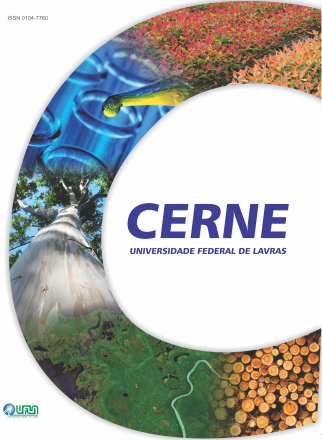Arranjo estrutural e dinâmica de crescimento de Eucalyptus spp., em sistema agrossilvipastoril no cerrado
Cerne
Arranjo estrutural e dinâmica de crescimento de Eucalyptus spp., em sistema agrossilvipastoril no cerrado
Autor Correspondente: Gabriel Corrêa Kruschewsky | [email protected]
Palavras-chave: sistema agroflorestal, espaçamento, eucalipto, produção
Resumos Cadastrados
Resumo Português:
Objetivou-se neste trabalho avaliar o comportamento silvicultural e produtivo de Eucalyptus spp., sob quatro diferentes
arranjos estruturais de sistema agrossilvipastoril, no cerrado de Minas Gerais, em cinco épocas, até os 67 meses de idade. O
experimento foi implantado em dezembro de 1999, em área de cerrado no noroeste de Minas Gerais, municÃpio de Paracatu, MG,
Brasil. Realizou-se o plantio de mudas clonais de um hÃbrido natural de Eucalyptus camaldulensis Dehnh com Eucalyptus urophylla
S.T. Blake, selecionado para a produção de madeira para serraria. O plantio foi feito em consórcio com arroz no primeiro ano, soja no
segundo e Brachiaria brizantha nos anos seguintes. O delineamento utilizado foi o de blocos casualizados, composto por 4 tratamentos
(3,33 x 2m, 3,33 x 3m, 5 x 2m e 10 x 2m), com cinco repetições. As avaliações foram efetuadas em cinco épocas: 18, 27, 38, 51 e 67
meses após o plantio. Constatou-se que, aos 18 meses de idade, o volume por planta não mostrou diferenças entre os distintos
arranjos, sendo maior no arranjo mais amplo (10 x 2m), a partir dos 38 meses após o plantio. A partir do segundo ano, quanto maior
a área útil maior foi o DAP. Com o passar do tempo, a taxa de crescimento diminuiu nos espaçamentos mais reduzidos. Verificou-se
também que a produção individual foi maior no espaçamento mais amplo e, até os 67 meses a produtividade do povoamento foi mais
influenciada pelo número de indivÃduos por área do que pelo arranjo estrutural.
Resumo Inglês:
This work evaluated the silvicultural and productive behavior of Eucalyptus spp. under four different structural
arrangements of agrosilvipastoral system in cerrado of Minas Gerais in five points in time till 67 months of age. The experiment was
established in December of 1999 in a cerrado area of Votorantim Metais, in the Northwestern of Minas Gerais (Paracatu, MG, Brazil).
Clonal seedlings of a natural hybrid of Eucalyptus camaldulensis Dehnh with Eucalyptus urophylla S.T. Blake were planted for
lumber production. The mixing with rice in the first year, soybean in the second and Brachiaria brizantha for the following years was
established. The utilized experimental design was randomized blocks, composed of 4 treatments (3.33 x 2m, 3.33 x 3m, 5 x 2m and
10 x 2m) with five replicates.The experiment was evalueted at 18, 27, 38, 51 and 67 months post-planting. It was found that till the 18
months of age, the volume per plant showed no differences among the distinct arrangements, but being bigher in the widest arrangement
(10 x 2m) from the 38 months post-planting. From the second year on, the larger the useful area the larger was he DAP. As time past
by the growth rate decreased in the most reduced spacings. It was found also that the individual production was larger in the widest
spacing and, till the 67 months, the stand yield was more influenced by the number of individuals per area than by the structural
arrangement.

